Levine Connection

Charlotte Harvest Exchange: Fresh Produce, Smiling Faces
by Jordane Williams ’24
Beginning in the fall of last year, Galen Miller, Kaitlyn Gosline and I worked diligently in planning our project. This semester, we finally felt the excitement of watching our civic engagement project culminate into fruition. During the summer after her first year, Kaitlyn completed her nonprofit internship with The Bulb, an organization committed to distributing fresh produce around the Charlotte region. The connections she made during her time at The Bulb served as the spark that started it all,
and the nonprofit serves as the supplier for our fresh markets. The original idea, with the endearing name “Cans for Carrots,” was set to be a market where participants exchanged canned goods and other nonperishables for fresh produce. In the first iteration of this project, the collected canned goods would then be distributed to the Jamil Niner Student Pantry in a circular system that benefitted The Bulb, students, and the Niner Student Pantry.




Fall 2023 Volume 15 Edition 1
1 Participants received t-shirts in exchange for recyclables.

A few months later, the concept of the project evolved, and we had to say goodbye to the beloved name “Cans for Carrot.” The new idea, taking the familiar name “Charlotte Harvest Exchange,” would have participants trade in plastic bags, berry containers, and egg cartons for produce and merchandise. Our aim was to provide affordable fresh produce to college students, faculty and staff to promote food security and nutrition. Last month’s successful market was proof that we could achieve this goal.
Our civic engagement project had its inaugural market on Wednesday, October 11, in front of the Rowe Arts building. With two staff members from The Bulb, three other Levine scholars who volunteered, and Galen, Kaitlyn and I, our market was well staffed. We were able to keep the entire event running smoothly from start to finish.
For this inaugural market, we ordered 800 pounds of produce, consisting of apples, cucumbers, squash, kale, collard greens, cabbage, corn, peppers, potatoes and sweet potatoes. Produce was given away for free to participating students, faculty and staff. Individuals who brought plastic bags, berry containers or egg cartons to swap were given cool branded merchandise at the low exchange rate of five items per shirt. Going into the market, we felt nervous about the outcome. After all, this project was a novel one. However, as soon as the market started, a very long line formed, to which we were all pleasantly surprised. Participants came excited to secure themselves great seasonal produce, all with smiles of satisfaction as they were served.
While the line grew longer, the produce supply became shorter. In no time, we were out of kale, then cucumbers, then cabbage, then corn. There were so many participants that, approximately 45 minutes into the three hour market, we had run out of many important items. Still, the line showed no sign of slowing down. We continued serving produce until the very last item was given out. We looked at
each other amazed at all the produce that had been consumed. The market was certainly a hit. Not only was produce given out, but numerous plastic bags, berry containers and egg cartons were exchanged for merchandise. The branded t-shirts were a great incentive for the swap, so much so that many who forgot to bring their recyclables went back to their dorms and returned with materials later on. Overall, we were very pleased with the result of our market.
With the success of the first market, we made sure to double the amount of produce for the second market. On Monday, November 13, we assembled once again in front of the Rowe Arts building, this time with confidence and familiarity from the last rodeo. Although it was a somewhat chilly day, we were still eager to give out free produce. At this market, we had apples, tomatoes, green bell peppers, kale, collard greens, carrots, spaghetti squash, potatoes and sweet potatoes. There was much less foot traffic than at the first market, perhaps attributable to the fact that it was a Monday. Still, we managed to give out a sizeable amount of our produce, especially the popular choices of apples and kale.

Breaking down the market, we celebrated the successful realization of our semester’s two markets. Our goal of impacting the UNC Charlotte community through healthy and accessible food was certainly achieved. On a personal level, seeing this project unfold has been rewarding. Regularly volunteering at the Jamil Niner Student Pantry, I have always championed the mission of food security and affordability. With the Charlotte Harvest Exchange, Galen, Kaitlyn and I were able to provide fresh, nutritious produce free to students, faculty, and staff. Out of what we have achieved, this result has been the most meaningful to me. We plan on having two more markets in the spring semester. Our hope is that by the time we graduate, Charlotte Harvest Exchange will be a name synonymous with food security, nutrition and charity.
2
From Morehead to Levine
by Dr. Mike Richardson
In April 2009, Mr. Levine noticed my Morehead Scholarship certificate at my medical office and asked me what that experience meant to me. After I described the impact that experience had on my life’s trajectory, he pondered “I wonder if we could do something like that in Charlotte?” Less than a week later, after furiously paced consultations with UNC Charlotte’s leadership, educators and surveying top merit scholarships across the country, I presented to Mr. Levine an approximately 40-page document outlining the main components of the Levine Scholars Program as it exists today. Fortunately, he and his wife Sandra liked the idea, improved it, and he used his business skills to craft a unique funding partnership with the university to launch and sustain the program.
Now, I help manage the ongoing relationship with The Leon Levine Foundation and the Levine Scholars Program, keeping the foundation board and staff aware of scholar and program related activities. I am the point person for the funding contract renewal process from the foundation board’s perspective. My wife Kelli and I remain heavily involved in creating and hosting the Into to the Arts events, football tailgates and other opportunities throughout the year.
At the Foundation, I am the Senior Program Officer for our Healthcare Mission area and
manage our grant portfolio across the Carolinas. We fund nonprofit partners who increase access to healthcare for the underserved populations in our states. I work both directly with these nonprofits, as well as build relationships with like-minded foundations, government and educators as we seek solutions to persistent and pressing issues—such as the youth behavioral health crisis in our states and the shortage of healthcare workers that we are currently experiencing.
I am also a member of the board of directors, and thus have responsibilities across The Leon Levine Foundation as we work to continue to follow Mr. Levine’s vision to empower people and invest in communities, seeking to create pathways to self-sufficiency, championing strategies for permanent change and facilitating opportunities for growth.
My main LSP role from the foundation’s perspective is to manage the contractual relationship between the foundation and the university in regard to LSP and shepherd the grant renewal cycles. My work related to the cultural enrichment programming is all volunteer and relates to my shared passion with the Levines’ to highlight Charlotte’s fabulous arts community and share a love and appreciation for the arts with our scholars.


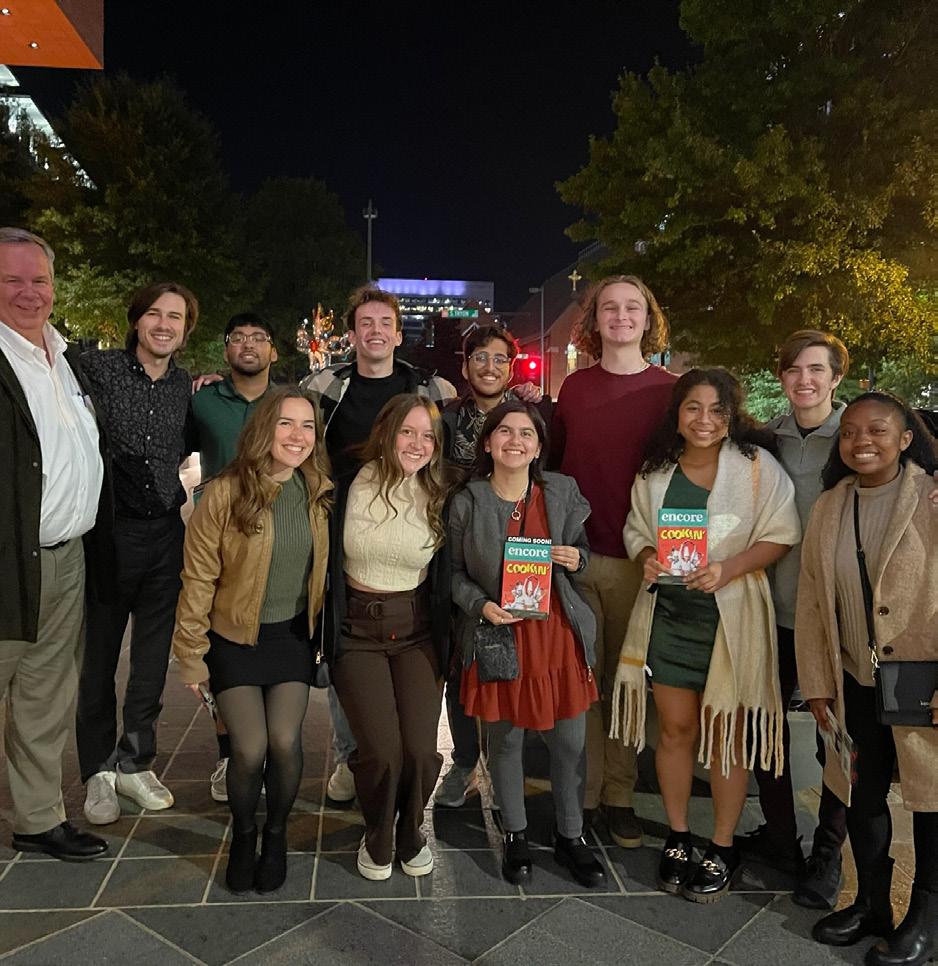 Dr. Mike and a family friend at an LSP football tailgate.
Scholars and an alumnus gather for a performance of “Cookin’.”
Dr. Mike and a family friend at an LSP football tailgate.
Scholars and an alumnus gather for a performance of “Cookin’.”
3
Mr. Leon and Mrs. Sandra Levine and Dr. Mike and Mrs. Kelli Richardson
A Little Extra Sugar
by Chandu Changalvala ’25

I spent many of my summers in sickly, warm humid areas. Whether it be in the bipolar weather of the Carolinas, more forgiving, weathered places such as Indiana, or India’s most searing scorching climate, I could hide away from the heat in the sanctuary of air-conditioned rooms, shade and refreshing drinks. However, unlike the heat and the sun rays, which I could run away from, mosquitos were a more challenging battle. They followed me everywhere I went and wouldn’t leave because I was inside four walls. My family would always laugh and point after I came inside dotted with red, itchy, swollen bites, no matter how short the duration of my outside adventure was. “Your blood has a little extra sugar,” they’d say. Although I’ve been pestered by these creatures my whole life, I have been fortunate to walk away with bites and scratches. Others worldwide with a “little extra sugar” in their blood aren’t always that lucky.
Malaria is caused by Plasmodium parasites, which have a complex life cycle involving mosquitos and humans. When an infected female Anopheles mosquito bites a human, it injects saliva containing plasmodium sporozoites into the bloodstream. The sporozoites travel to the liver and infect liver cells, where they multiply asexually into thousands of merozoites over 6-15 days. The infected liver cells eventually burst, releasing merozoites into the bloodstream, infecting red blood cells. Inside red blood cells, the parasites multiply further and destroy the cells, causing fever, chills and other malaria symptoms. Inside the mosquito gut, the gametocytes mature into gametes that fuse to form zygotes. The zygotes develop into ookinetes, then oocysts, which rupture to release thousands of sporozoites. The sporozoites migrate to the mosquito’s salivary glands, ready to infect a new human host when the mosquito feeds again.

Insect repellant is a luxury for many populations impacted by mosquitos carrying Malaria.
Although this process sounds complicated and has fancy names such as gametocytes, zygotes and sporozoites, malaria is as uncomplicated as a bug bite to get, and due to how easily it develops in the body, a cure and further vaccine developments are nearly impossible to create. Dr. Kausik Chakrabarti, an Associate Professor with tenure in the Department of Biological Sciences, runs a lab investigating the genomics and molecular mechanisms of RNA function in human parasites. The Chakrabarti Lab utilizes cutting-edge tools to understand the conformational changes of RNA within ribonucleoprotein (RNP) complexes and essential RNA-protein interactions necessary for parasite biological functions. Their long-term goal is to use these insights into RNA behavior and interactions to develop novel RNA-based therapies targeting unicellular pathogens that infect humans.
When I emailed Dr. Chakrabarti, expressing my interest in his work and my fascination for his and his team’s work, he welcomed me with open arms. His team and his Ph.D. students were all patient and willing to explain even the most basic concepts
4
that I felt were hard to grasp with my rudimentary knowledge of biology. My summer quickly split into two battles: finding a way to not get bit by the bugs on my way to the lab and protecting others from the diseases they carry. The same hands that swatted away the mosquitos were almost methodically memorizing the process to observe malaria take action in the blood.
Several essential procedures exist for starting and maintaining a malaria culture to guarantee that malaria parasites thrive and spread successfully. The cells are harvested and then resuspended in Trizol to preserve the RNA. If RNA extraction is not done immediately, the Trizol sample can be kept at -80 ° C. The Trizol sample is mixed with chloroform to extract the RNA from other biological components. The RNA is further purified using various reagents and ethanol after incubation and centrifugation. The NanoDrop and Qubit systems are then used to assess the concentration and quality of the isolated RNA. Strict procedures and meticulous monitoring of the environment, nutrients and growth stages are required to maintain the malaria culture to guarantee the parasites’ ongoing growth.
Cultivating malaria took a lot of work: careful planning, attention to detail and following stringent guidelines. The importance of the tools used for malaria culturing became clear because they were essential for getting excellent RNA samples for analysis. Trizol, in particular, acted as a necessary chemical for cell lysis and RNA preservation. For accurate data to be obtained, it had to efficiently disrupt cells and guard against RNA degradation throughout the extraction process.
I learned the value of patience and accuracy in the lab while cultivating malaria and extracting RNA. To ensure precise results, each step—from selecting
the cells to determining the concentration of RNA— required careful execution. I gained confidence and competence in my ability to handle sensitive samples and carry out a variety of procedures, including pipetting and centrifugation.
In addition, the internship made me aware of how important RNA is to understanding malaria and other infectious diseases. The genetic makeup of conditions, their pathogenicity and prospective therapeutic targets can all be learned by RNA analysis. Working on a study involving malaria highlighted the significance of preventing infectious illnesses and the function of science in resolving global health issues. Developing effective therapies and prevention measures requires a better understanding of the illness, which is still a significant burden in many regions worldwide. Dr. Chakrabarti and his team allowed me to participate in this change, even for only a few months. From now on, mosquito-filled summers will have a different meaning for me: the little extra sugar in my blood was the reason I was a part of a change in the world.

5
Perspectives: A Month in Amsterdam Embracing Culture, Class and Adventure
by Jamari Tyson ’24
Visiting other countries seemed like a faraway dream to me. I never thought that I would receive the opportunity to travel abroad at such a young age. However, thanks to the Levine Scholars Program, I was able to fulfill this dream and experience a culture vastly different from America. On May 15, 2023, I found myself standing at Amsterdam Airport Schiphol in Amsterdam, Netherlands, juggling several loaded bags and ready to take on a new adventure. I had traveled to Amsterdam to take part in a study abroad program hosted by CIEE, the Council on International Educational Exchange.
CIEE housed us in Hotel Jansen, a newly built longterm hotel for tourists and students. Located on the outskirts of Amsterdam, this hotel was the perfect place for privacy but also close enough to the main attractions of the city. In fact, the metro station was only five minutes away from the hotel! Once I received access to my personal room, I went and rented a bike because I knew it would be crucial for me to get around Amsterdam. There are three main forms of transportation that people use to get around Amsterdam: car, metro and bikes. Cars are the least common due to the limited parking in Amsterdam and the country’s commitment to becoming climate-friendly. The metro is a popular form of transportation due to its reliability, accessibility and practicality. Without a doubt, the most common form of transportation in Amsterdam is bike riding. The Dutch use bikes as much as Americans use cars; in fact, it is common to see a horde of bikers riding down the streets of Amsterdam during rush hour traffic.
The first day of class was nerve-racking for me. I did not know my way around Amsterdam, and I did not want to be late for class. I also wanted to get the authentic Amsterdam experience, so I decided to ride my bike to class instead of taking the metro with my peers. I set out for class two hours early to make sure I made it on time and got used to the biking system in Amsterdam. What started out as an anxious first ride turned into a morning routine that I looked forward to. I fell in love with the beauty of Amsterdam with unique architecture and its charming canal system. It only took me 30 minutes to get to class that first morning, which is equivalent to the 30 minute ride on the metro. I then explored the University of

 Amsterdam before I attended my first Intercultural Communications class!
The Mona Lisa looks smaller in person.
Amsterdam before I attended my first Intercultural Communications class!
The Mona Lisa looks smaller in person.
6
Jamari biking through the streets of Amsterdam.
Undoubtedly, the Intercultural Communications class was one of the most unique and thought-provoking classes I had ever taken. It was taught by a welltraveled woman named Evy who was a teacher, writer and artist all in one. The class periods each day were four hours long, but the way she taught made it seem much shorter. The class focused on observing the cultures and norms in a variety of cultures and reflecting on the differences in our day-to-day life at home. One of my favorite lessons was the difference between Culture and culture. Culture with the big C was presented as facts and information you learn about a country though that can easily be found on the internet or in a book. Culture with the little C was the more interesting aspect, and it involved examining behaviors, moods, manners and customs of the country you are visiting. The time spent in that classroom is something I will always cherish because it encouraged me to think critically about the differences that are present in everyday life.
My free time in Amsterdam was spent traveling to various museums, exploring different foods and attending concerts. My favorite museum that I visited was the Nxt Museum, a futuristic museum that focused on technology and special effects to present abstract concepts to spectators. I really enjoyed this museum because it was unconventional compared to your typical art and painting museum. My favorite food spot was Winkel, a coffee shop and brewery, because it had some of the best apple pie in Amsterdam. Amsterdam is known for its apple pie, so I decided it was my personal mission to try as many pies as I could and rank them. One of my favorite experiences in Amsterdam was attending an SZA concert. I never would have imagined that I would be attending an American R&B concert in the
Netherlands, but I had a great time singing some of her hits such as “Kill Bill and “Snooze” with the crowd.
One of the greatest things about Europe is the ability to travel between countries seamlessly. I had the opportunity to take trips to Brussels and Paris during my trip when we had extended weekends and a break from class. Paris was the first trip, and it was nothing short of an amazing experience. The group I traveled with decided to save money by riding a bus to Paris and renting an Airbnb. One of our top destinations was the Louvre, and it was as beautiful and captivating as pictures made it out to be. We even got to see and pose for a picture with the Mona Lisa! Being a foodie, I also convinced the group to wait two hours in line at a world-famous steak and fries shop. The steak and fries are on my top 10 list of best foods I have ever eaten. Later, on our day trip to Brussels, we explored the city’s parks, architecture and food spots. Of course we had to try an authentic Belgian waffle. Overall, it was a pleasant day trip to another country, and also crazy to think that you can visit another country in just a day.
The conclusion to my month-long study abroad was pleasant but bittersweet. I had to say goodbye to the city that I had fallen in love with and the relationships I had made with my study abroad friends. It felt bad to leave, but it wasn’t a proper goodbye. It was actually a see you later because I plan on returning to Amsterdam to explore more of what it has to offer. I also plan on setting out on more adventures with the friends I made during the study abroad experience. My international study abroad experience through the Levine Scholar Program is a memory that I will cherish and always hold dear.

7

Women’s Health and Community Action
by Kayla Walker ’25
According to The Centers for Disease Control and Prevention (CDC), the risk of pregnancy-related deaths for Black women is three times higher than that of white women. The CDC also reports that 60% of all pregnancy-related deaths are preventable. Racial disparities and biases persist in the field of obstetrics leading to the countless deaths of Black mothers across the United States. In high school, I completed my STEM senior capstone project about the maternal health disparities and biases in medicine. We were able to complete an educational session with aspiring healthcare professionals about common medical misconceptions by race, educate about maternal mortality disparities and introduce doulas as a potential field they may be interested in. This project led me to having an overwhelming interest in women’s health. Coming to Charlotte as a Levine Scholar, I wanted to use the opportunities available to me to understand the state of women’s health in the city, work with local organizations that address women’s health issues, and join clubs and organizations that support the cause.
During the end of my first year in the Levine Scholars Program, I learned about an existing civic engagement project with the Salvation Army Center of Hope, a homeless shelter for single women and families.

8
Kayla’s civic engagement project provides sanitary goods to women and children in need.
The goal of this project was to provide broad health education to the women and children of the shelter and supply essential products for self-care. Each session had a different focus such as dental, skin, eye, or mental health. Learning about this project sounded perfect for me because it combined my interests in medicine and public health while serving a community that was important to me. The opportunity to interact with the women during the educational sessions made the project stand out the most. I loved having meaningful and engaging conversations with the residents about their health.
Through my work with this civic engagement project and other community focused activities I participated in within Charlotte, I was nominated for the Campus Compact Newman Civic Fellowship by Chancellor Sharon Gaber. This fellowship is a year-long program that recognizes and supports student problem solvers. I am very grateful for the opportunity to attend the 2023 Newman Civic Fellow Convening with support from the Levine Scholars Program. Throughout the weekend, I was able to connect with other Newman Fellows from across the United States, hear about their public service projects from a range of disciplines, and develop strategies to enact changes in my community.
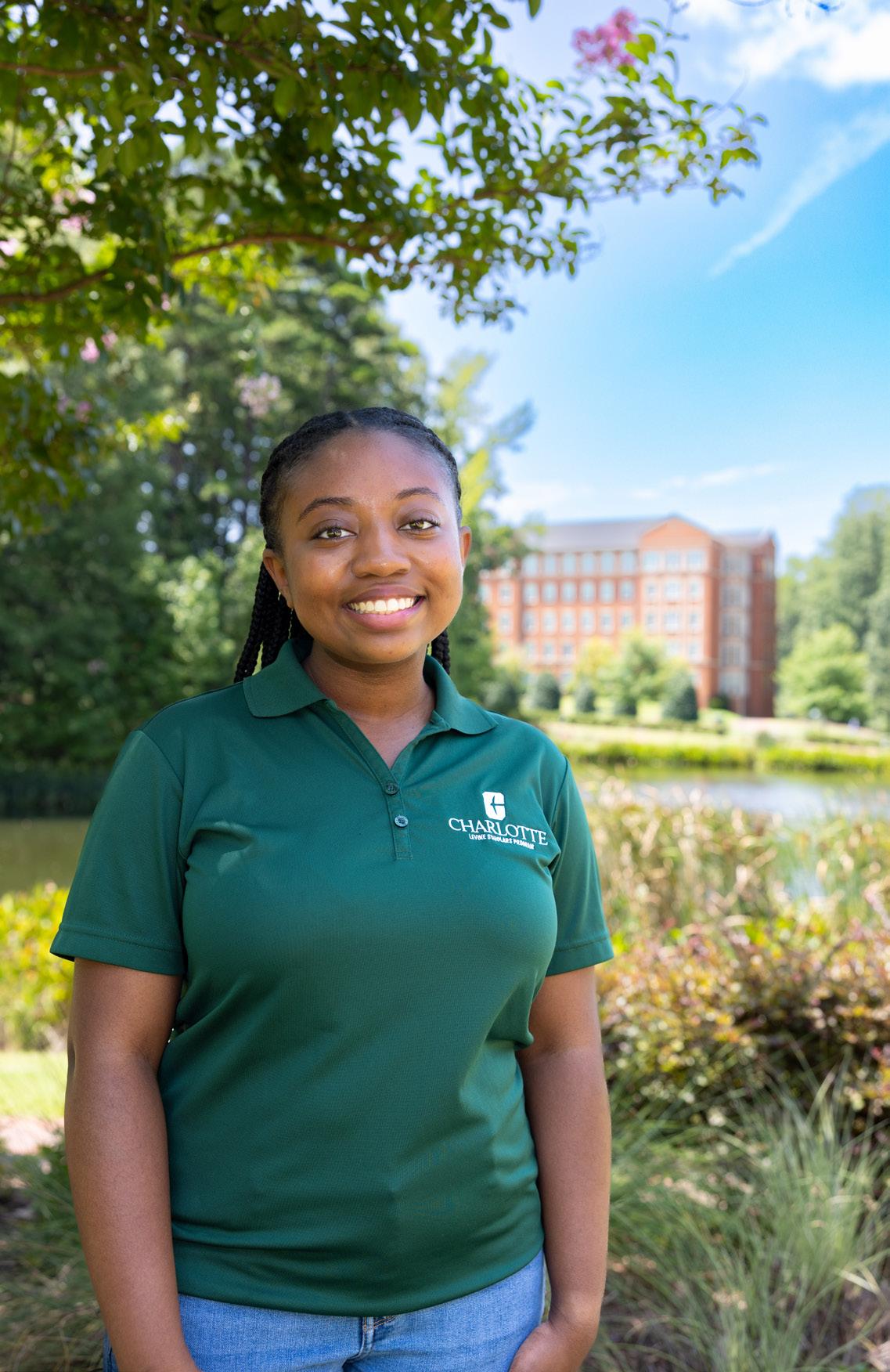
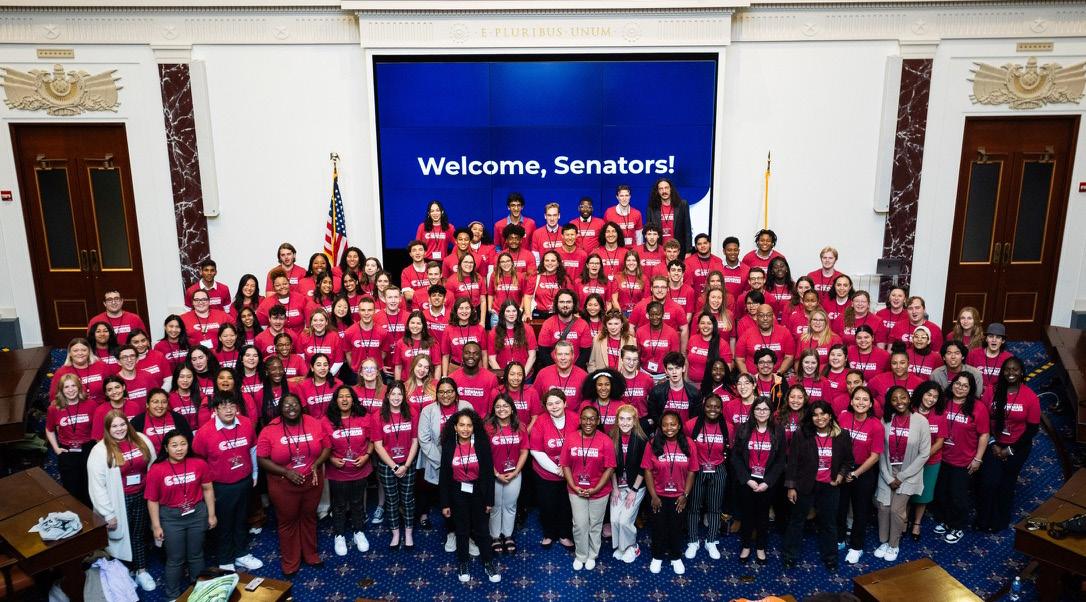
9
Kayla represented UNC Charlotte at the Newman Civic Fellow Convening in 2023. Levine Scholars have been chosen for this honor for eleven years in a row.
Convivencia: A Peace Corps Mexico Experience
by Xavier Gomez ’23
Sharing a cowboy hat full of fresh-picked fruit with a crew of biologists, a civil engineer, ranchers and their goats was not exactly how I planned on spending my Tuesday before Thanksgiving. Many of the topics that we chatted about were reminiscent of a holiday family dinner, however. Food, sports, politics, even former lovers - one rancher had an ex-girlfriend who was from a biologist’s hometown; he had lost contact with her and wanted to know how she was doing. As we know from NOLS (I wore my NOLS boots on this trip!), a good hike is apt to create these kinds of conversations.
I am a Peace Corps Volunteer working in the field of Climate Change awareness and action in Central Mexico. On this particular trip, I was accompanying the team of experts who run the reserve—a kind of massive national park that has tens of thousands of people who live within it—on a site visit of one of their collaborative projects. The natural habitat in this area has been affected by hundreds of years of cattle grazing that has eroded the soil and cleared much of the natural flora, as well as the increasing temperatures and lack of rainfall that have plagued the country for the last several years. The reserve has been working with the local ranching community to construct a series of check dams, water tanks fed by underground springs, bird perches and rock walls to save water and prevent erosion. The ranchers proudly explained to me that many of the check dams were built in the ruins of older dams constructed by the Mixteca, an ancient indigenous culture whose descendants still occupy the valley. A physical reminder of how humans have been shaping their natural environment for far longer than what we think of as this current “modern” age.
A gathering of Xavier’s colleagues.
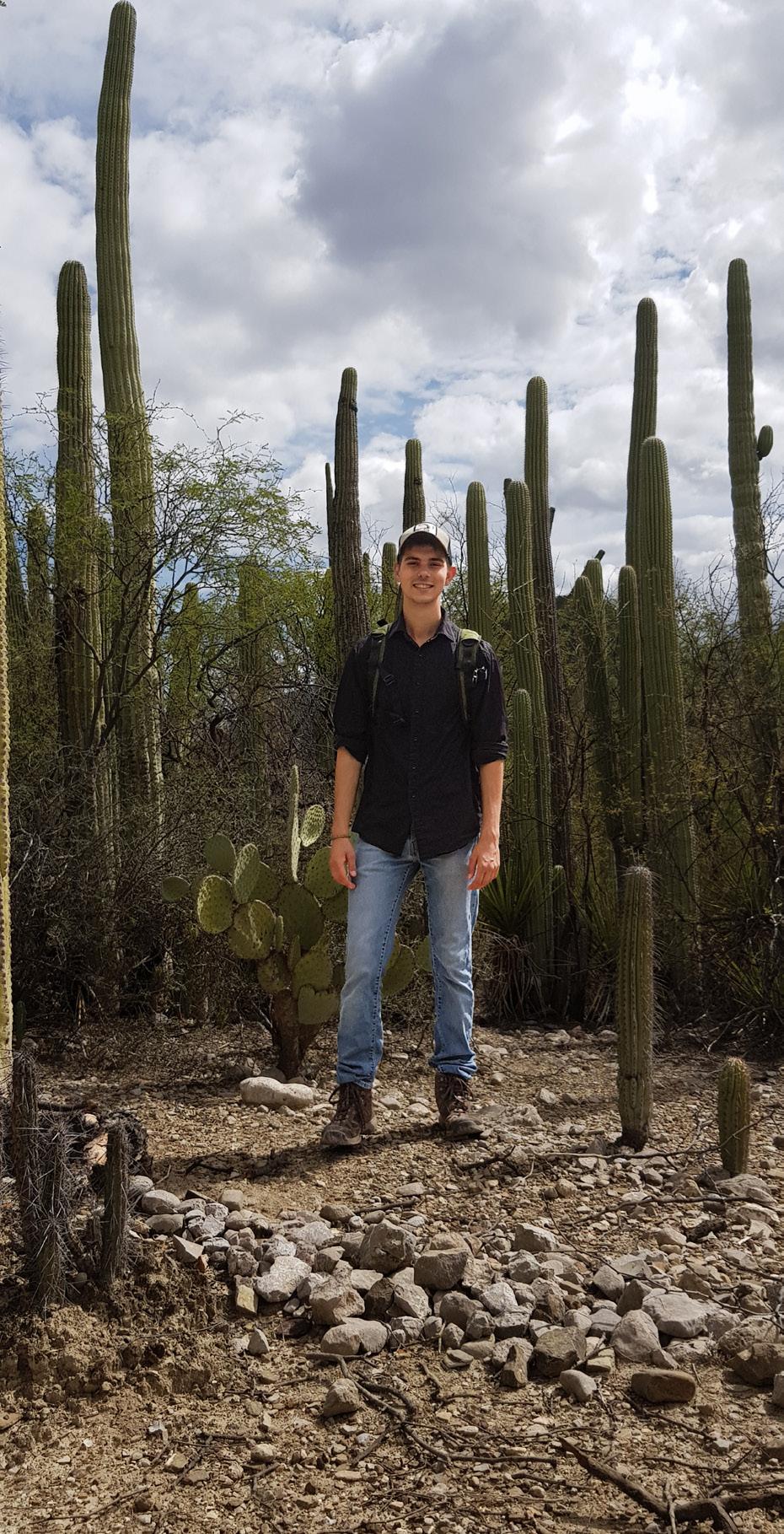
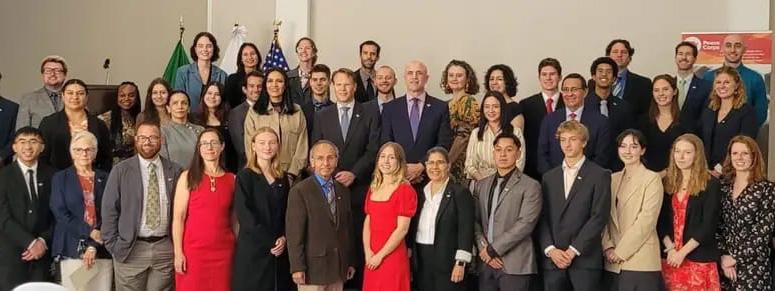
10
With the support of my community and a lot of elbow grease, I’ll be able to organize similar projects in my own small town elsewhere in the reserve. I’ve lived in this valley of cacti, mesquite trees and ancient salt flats for only a month, but I’m already very attached to the people and the landscape here. Prior to moving to this town, I attended training in the bustling city of Querétaro, a rapidly-growing city of 2 million that reminded me of Charlotte in a lot of ways—from its vibrant restaurant culture to its mediocre public transportation. There, my fellow volunteers and I were taught ecological gardening techniques, waste management, teaching pedagogy, Spanish language skills and cultural tips to bring us up to speed on how to facilitate resilience against and awareness of climate change. I also made some amazing friends. We visited Aztec pyramids, went to dance classes, ate a lot of street food, spent many evenings playing soccer and explored the new country that we were learning to call home. It was very similar to a semester-long study abroad experience, except done at a more hectic pace due to the shorter window of time together. Fortunately, we did not have to say goodbye at the end of our training, as we are all now working in various states in Central Mexico and will be for the next two years.
My fellow volunteers are one of my strongest pillars of support, as we are all going through the same slow process of integrating into our communities. When we get the chance, we take the occasional weekend to visit each other’s sites to catch up and see a different part of Mexico.
In my permanent site, I’m meeting many new faces and learning a lot about the natural environment from the people who live here. My town has a wealth of knowledge about the flora and fauna in this region. From what plants can be used for food and medicine to the migration patterns of bird species, they’ve maintained their relationship with the land that was present well before they were colonized by the Spanish and continues to be made deeper today. Now, many work as guides and researchers in the reserve. It’s a humbling and enlightening experience to go on a hike with someone who’s lived here their entire life, as they’re always pointing out minute details in our surroundings—the shapes and seasons of flowers, little hidden caves that shelter bees or the tracks of a bobcat or a puma. Often, it’s tasty too, as they are quick to find and offer up juicy cactus fruit.
The people in my site also have a great deal of knowledge about the U.S. Almost every man over the age of 30 and many of the women have migrated there to work and
send money back to their family here. Due to a changing climate and trade deals between the U.S. and Mexico, it became impossible to continue with traditional farming in Mexico and people in rural areas had to search for other opportunities. This meant searching for a way to earn a living in larger Mexican cities or migrating to the U.S. to work, resulting in a complete change of lifestyle and a strong dependency on outside income for rural communities in Mexico, which were previously selfsufficient. One of the most difficult questions that I get about the U.S. are how Americans perceive Mexicans. While many people in my town have lived in the states for years and are well aware of our demand for their labor, they’re still not certain how we view them. I’m not sure either. Most of the time, I try to express positive things in the spirit of friendship between our countries. However, the way that immigrants, particularly from the global south, are treated as disposable by the U.S. government and by a portion of our own people, as confirmed by the lived experiences of my neighbors, necessitates nuance and honesty.
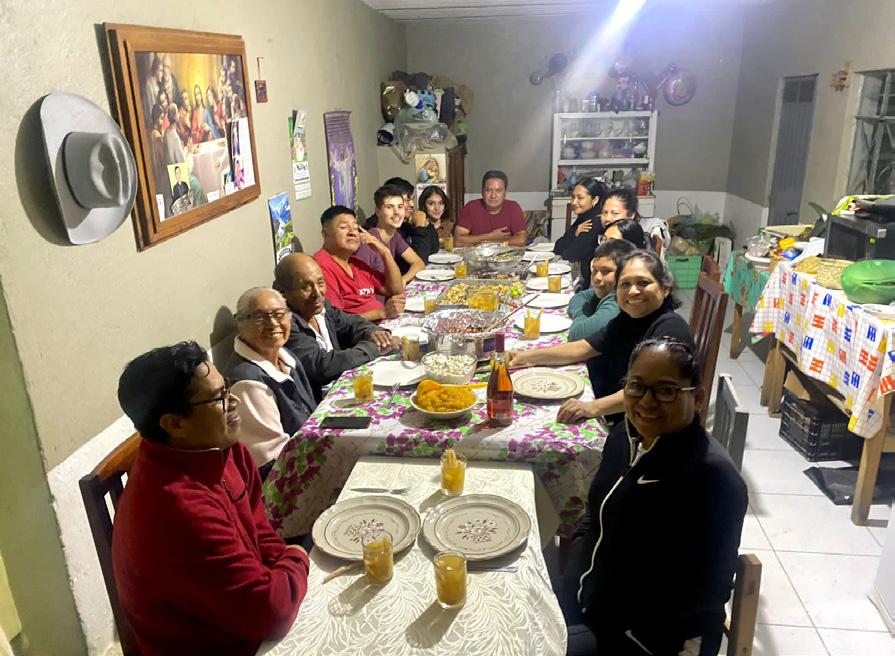
This Thanksgiving was my first away from my biological family. To take my mind off things and express my gratitude for my wonderful host family, I cooked for a party of 16. It was surprisingly well-received, despite the general lack of spicy food, and everyone was eager to participate in “Turkey Day”, as they like to call it. It was good to be reminded of the love and support that my host family shares with me. Convivencia, literally translated as “coexistence,” is critical to Mexican culture. It is the practice of sharing a meal with others and spending time together. Around the dinner table—or cowboy hat full of fruit—you get the chance to learn how other people see the world and share a little bit of your own life. I’m just starting my journey and am very much looking forward to deepening my understanding of this country and my relationships with all of my friends here. After all, who doesn’t love good food and a bit of company?
11
Thanksgiving dinner with Xavier’s host family in Mexico
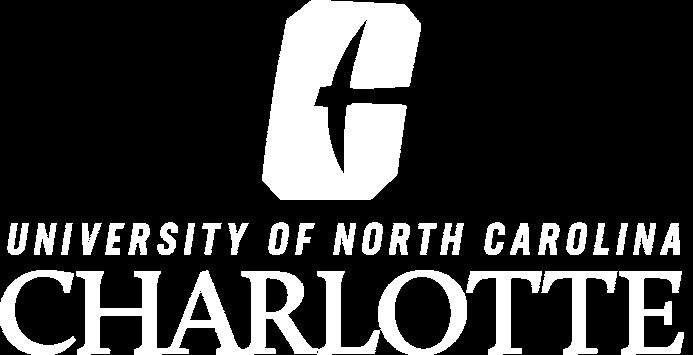
The Levine Scholars Program
9201 University City Boulevard
Charlotte, NC 28223
levinescholars.charlotte.edu
704-687-5880
The Levine Scholars Program is a four-year merit scholarship that includes full tuition, room, board and four summer experiences, including study abroad, which will develop leadership skills and social awareness. In 2010, the inaugural class of Levine Scholars enrolled at UNC Charlotte and approximately 20 scholarships are awarded to high school seniors every year. The Levine Scholarship is valued at $105,000 for in-state students and $155,000 for out-of-state students over four years.
Levine Scholars are talented high school seniors from across the United States whose accomplishments epitomize the values of philanthropists Sandra and Leon Levine, including a demonstrated commitment to community service, intellectual curiosity and the capacity for ethical leadership. Through community engagement, mentoring relationships with civic and business leaders in Charlotte and a rigorous academic program, Levine Scholars develop the characteristics necessary to produce positive change in the communities in which they live and work. Scholars are able to turn their community service interest into actions with community service grants of $8,000 to support their work in the community.
It is this unique connection to Charlotte—its resources, leaders and challenges— that differentiates this program from other scholarships of its kind. The program is specifically designed to expose Levine Scholars to the urban culture of a thriving city and to engage them in service to address needs of the citizens of Charlotte.
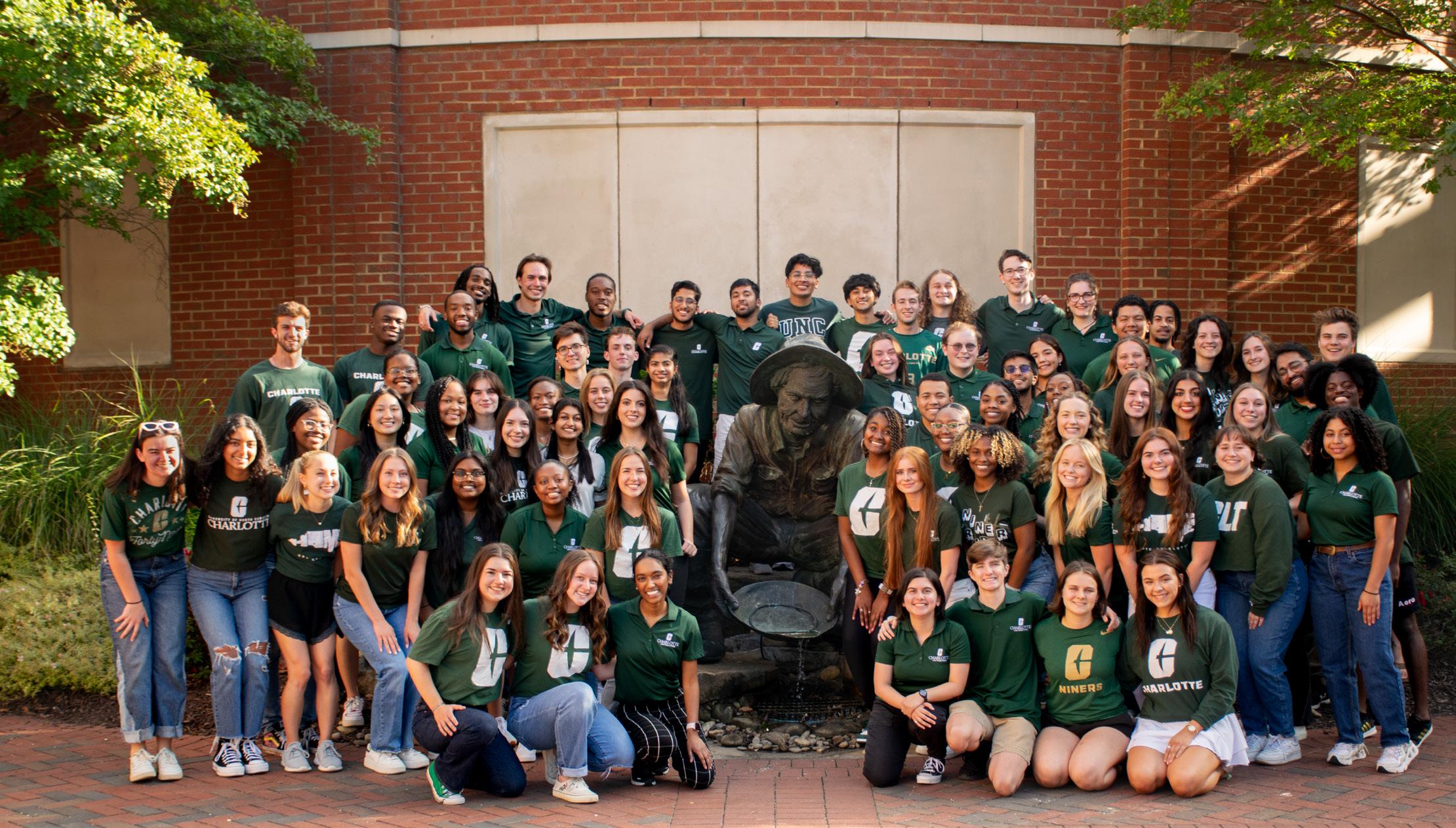
12










 Dr. Mike and a family friend at an LSP football tailgate.
Scholars and an alumnus gather for a performance of “Cookin’.”
Dr. Mike and a family friend at an LSP football tailgate.
Scholars and an alumnus gather for a performance of “Cookin’.”




 Amsterdam before I attended my first Intercultural Communications class!
The Mona Lisa looks smaller in person.
Amsterdam before I attended my first Intercultural Communications class!
The Mona Lisa looks smaller in person.









